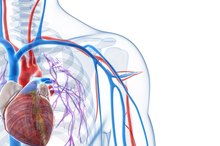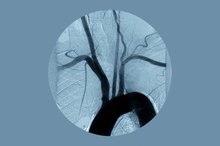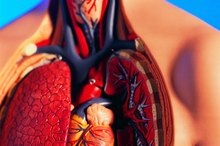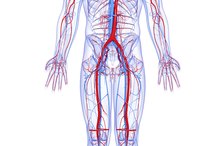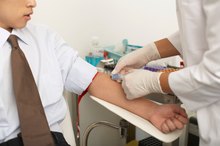What Are the Three Types of Blood Vessels in Our Bodies?
The circulatory system is the body’s transportation superhighway. As the blood circulates through the body, it brings oxygen and nutrients to the body tissues and picks up the waste products, delivering them to the kidneys and lungs to be expelled. The heart is the pump of this closed-circuit system. Three types of blood vessels comprise the circulatory system: arteries, veins and capillaries 23.
If you are experiencing serious medical symptoms, seek emergency treatment immediately.
Arteries
Arteries carry oxygen-rich blood away from the heart to the organs and tissues of the body. The arterial system is under high pressure as it receives blood from the pumping heart. Therefore, the walls of arteries are thick. They contain elastic fibers and muscle cells, which help propel the blood through them. Commonly known arteries of the human body include the aorta, the femoral arteries, the carotid arteries and the coronary arteries.
- Arteries carry oxygen-rich blood away from the heart to the organs and tissues of the body.
- They contain elastic fibers and muscle cells, which help propel the blood through them.
Capillaries
The 4 Parts of the Cardiovascular System
Learn More
Capillaries are tiny blood vessels that connect the arterial and venous sides of circulation 23. The walls of these vessels are only one-cell thick to allow for easy exchange of substances in the tissues. Oxygen is transported out of the capillaries into the tissues; carbon dioxide flows in the other direction, from the tissues into the capillaries. Similarly, nutrients and waste products cross back and forth as needed, across the capillary walls.
Capillaries also have a role in regulating body temperature. When excess heat is present in the body, the capillaries release the heat into the tissues. You have surely noticed how your skin turns pink on a hot summer day or after you have taken a jog--that flush is the result of your capillaries working to rid your body of excess heat.
- Capillaries are tiny blood vessels that connect the arterial and venous sides of circulation 2.
- When excess heat is present in the body, the capillaries release the heat into the tissues.
Veins
The venous side of circulation carries deoxygenated blood that has picked up carbon dioxide back toward the heart and lungs. Venous circulation is under relatively low pressure compared to arterial circulation. Therefore, the walls of the veins are much thinner than those of the arteries. Veins have a feature not found in arteries--valves. Keeping in mind that there is not high pressure to force venous blood flow toward the heart, the valves are an aid to help prevent backflow and keep circulation a one-way system. Commonly known large veins of the body include the superior vena cava, the inferior vena cava, the jugular veins and the great saphenous veins of the legs.
- The venous side of circulation carries deoxygenated blood that has picked up carbon dioxide back toward the heart and lungs.
- Keeping in mind that there is not high pressure to force venous blood flow toward the heart, the valves are an aid to help prevent backflow and keep circulation a one-way system.
Related Articles
References
- “Robbins Pathologic Basis of Disease, 5th Edition”; Ramzi S. Cotran, M.D., et al; 1994
- Merck: Blood Vessels
- Ramasamy SK. Structure and functions of blood vessels and vascular niches in bone. Stem Cells Int. 2017;2017:5046953. doi:10.1155/2017/5046953
- Godwin L, Crane JS. Histology, capillary. StatPearls. Updated September 20, 2019.
- Monahan-Earley R, Dvorak AM, Aird WC. Evolutionary origins of the blood vascular system and endothelium. J Thromb Haemost. 2013;11 Suppl 1(Suppl 1):46–66. doi:10.1111/jth.12253
- Maynard RL, Downes N. Histology of the vascular system. Anatomy and Histology of the Laboratory Rat in Toxicology and Biomedical Research. 2019:91-95. doi:10.1016/b978-0-12-811837-5.00008-3
- Wong AD, Ye M, Levy AF, Rothstein JD, Bergles DE, Searson PC. The blood-brain barrier: an engineering perspective. Front Neuroeng. 2013;6:7. doi:10.3389/fneng.2013.00007
- Miller GE. Biomedical transport processes. Introduction to Biomedical Engineering. 2012:937-993. doi:10.1016/b978-0-12-374979-6.00014-9
- Hu D, Cai D, Rangan AV. Blood vessel adaptation with fluctuations in capillary flow distribution. PLoS ONE. 2012;7(9). doi:10.1371/journal.pone.0045444
- Pittman RN. Oxygen transport in the microcirculation and its regulation. Microcirculation. 2013;20(2):117–137. doi:10.1111/micc.12017
- Wright TC, Green E, Phillips JB, Kostyuk O, Brown RA. Characterization of a “blanch-blush” mechano-response in palmar skin. Journal of Investigative Dermatology. 2006;126(1):220-226. doi:10.1038/sj.jid.5700030
- McGrath A, Barrett MJ. Petechiae. [Updated 2019 Jun 8]. In: StatPearls [Internet]. Treasure Island (FL): StatPearls Publishing; 2020 Jan-.
- King D, Morton R, Bevan C. How to use capillary refill time. Archives of Disease in Childhood - Education & Practice Edition. 2013;99(3):111-116. doi:10.1136/archdischild-2013-305198
- Kumar P, Sait SF, Sharma A, Kumar M. Ovarian hyperstimulation syndrome. J Hum Reprod Sci. 2011;4(2):70–75. doi:10.4103/0974-1208.86080
- Krleza JL, Dorotic A, Grzunov A, Maradin M; Croatian Society of Medical Biochemistry and Laboratory Medicine. Capillary blood sampling: national recommendations on behalf of the Croatian Society of Medical Biochemistry and Laboratory Medicine. Biochem Med (Zagreb). 2015;25(3):335–358. doi:10.11613/BM.2015.034
- Freysz M, Cribier B, Lipsker D. Syndrome de Fegeler, angiome plan acquis ou malformation capillaire acquise : trois observations et revue de la littérature. Annales de Dermatologie et de Vénéréologie. 2013;140(5):341-346. doi:10.1016/j.annder.2013.01.436
- Sibley CD, Ramien ML. Capillary malformation–arteriovenous malformation Syndrome. JAMA Dermatology. 2019;155(6):733. doi:10.1001/jamadermatol.2019.0319
- Kapoor P, Greipp PT, Schaefer EW. Idiopathic systemic capillary leak syndrome (Clarkson's disease): the Mayo clinic experience. Mayo Clin Proc. 2010;85(10):905–912. doi:10.4065/mcp.2010.0159
- Ambati J, Fowler BJ. Mechanisms of age-related macular degeneration. Neuron. 2012;75(1):26–39. doi:10.1016/j.neuron.2012.06.018
- Genetics Home Reference. Capillary malformation—arteriovenous malformation syndrome. February 2019.
Resources
Writer Bio
Dr. Tina M. St. John owns and operates a health communications and consulting firm. She is also an accomplished medical writer and editor, and was formerly a senior medical officer with the U.S. Centers for Disease Control and Prevention. St. John holds an M.D. from Emory University School of Medicine.

